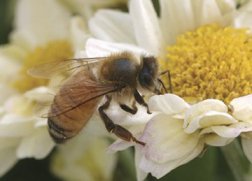Little Brains That Could: Bees show big-time working memory
A honeybee’s brain may fit on the head of a match, but a research team says that the bee’s working memory is almost as effective as that of a pigeon or a monkey.


Working memory is what a person relies on for those few seconds between reading a number from the phone book and punching the number into the phone, explains Shaowu Zhang of the Australian National University in Canberra. He and his colleagues tested honeybee memory by training bees to use exit signs in a chamber to find their way to a treat. To make the correct choice, each bee had to remember a clue it had flown by on its way into the chamber.
“The working memory in a bee is robust and flexible,” says Zhang. A short-term memory lasts about the same time in a bee as in a pigeon, he says. And a honeybee’s memory is flexible enough to perform a simplified version of a task employed to test memory in rhesus monkeys.
To look at details of the bee’s working memory, Zhang and his colleagues used variations of a layout with a wooden tunnel leading into an upright pipe. The two exit holes from the pipe were marked with different patterns. The researchers put a partition in the tunnel with a hole for bees to fly through. The partition carried a pattern, such as stripes slanting left. Bees had to remember the pattern and pick the matching pattern on one of the exit signs to reach the treat. During a bee’s training, the researchers regularly switched the patterns.
Once a bee was choosing correctly about three times out of four, the researchers repeatedly lengthened the tunnel beyond the partition. Thus, the flying bees had a longer and longer delay between seeing the pattern and matching it to the exit sign.
The bees’ memory of that pattern remains strong for about 5 seconds, the researchers report in an upcoming Proceedings of the National Academy of Sciences. In field tests, bees tend to choose flowers that resemble the one they visited some 5 seconds earlier. Birds’ short-term memory lasts a similar time.
To test flexibility of memory, Zhang and his colleagues put two partitions with patterns in the tunnel and taught the bees to pay attention to only one partition, such as the first one encountered or the one at a specific distance from the tunnel mouth. The bees still managed to match patterns even when researchers marked the partitions and exits with patterns not seen in training.
The bee test was a two-option version of a memory test in which rhesus monkeys can distinguish more options.
Thomas Collett of the University of Sussex in Brighton, England, says that the cues used by bees in the study aren’t clear but their flexibility is interesting. Also, he welcomes the memory-duration finding as a “valuable contribution, since measurements haven’t been available before.”